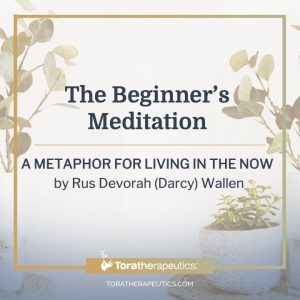Meditation a Metaphor (Part 2)
 In the last article, we discussed the fact that my “Beginner’s Meditation on the Breath™” is created intentionally with messages that are metaphors for “use” in day-to-day life. We provided a handout (“The Beginner’s Meditation on the Breath™” – A Metaphor for Living in the Now”) about it. Today, however, I will go into greater depth regarding this metaphor. The basic instructions of the meditation will be stated, and then I will share the explanation of how the messages embedded in the script bring us to the here and now.
In the last article, we discussed the fact that my “Beginner’s Meditation on the Breath™” is created intentionally with messages that are metaphors for “use” in day-to-day life. We provided a handout (“The Beginner’s Meditation on the Breath™” – A Metaphor for Living in the Now”) about it. Today, however, I will go into greater depth regarding this metaphor. The basic instructions of the meditation will be stated, and then I will share the explanation of how the messages embedded in the script bring us to the here and now.
Instructions:
- Sit or lie down comfortably. Close your eyes, pay attention to your breath, and notice anything to do with your breathing (i.e. the temperature, pacing, or movements in your body).
- Breathe comfortably at your own pace and speed.
- Notice any sensations in your body related to your breath.
- If your mind wanders, gently and non-judgmentally bring your attention back to your breath.
- Keep refocusing on your breath over and over.
- Allow the thoughts to pass like a cloud or leave floating down the stream.
- Commend yourself for taking time for your own well-being.
As I said last time, even though my meditation is very similar to other meditations, it Is distinct in two different ways. The first is that it’s devoid of any Eastern rituals (like gongs or bells or sitting positions or mantras), it’s a religiously neutral, yet scientifically proven focal attention method of calming the mind. The second aspect that distinguishes my meditation from many other mindfulness-type meditations is it has been composed with the intention that the word “breath” corresponds metaphorically to “life.” That is, embedded in the composition of the meditation itself is the metaphor for living life in the now. So, the premise is (and it seems to be working for my clients), the more regularly you practice the daily meditation and observe your daily life with the themes that are embedded in it, you’ll have more presence of mind. You’ll be able to stay in the present moment. You will gain greater emotional control. You’ll see significant changes in your life. You’ll be able to find more and more meaning in your life. You will become more grateful and appreciative for what you have.
I’d like to illustrate how the messages in the meditation apply to living in the here and now. The instructions in the meditation are to start paying attention and to notice any sensations related to your breath such as temperature, pacing, the current of the air in your body. The life in the now analog is staying present at the moment, paying attention to what you’re doing each moment of life by noticing and becoming more aware. What is the “current” like?
The next instruction is to breathe comfortably at your own pace and speed. The analog in life is that we need to live at our own pace, not compare ours to other people’s lives. You do what you’re comfortable doing what you’re capable of doing. Grow live at your own pace and speed not to please, appease, or compete with others. The next instructions from the meditation are to notice any sensations associated with your breath. The analog is to stay present and aware of your internal experience. Your visceral and emotional responses are informational and informative guides. Our “physical” feelings have a relationship to our “emotional” feelings and vice versa. The next set of instructions is if your mind wanders (which is the nature of the mind, to wander), gently and nonjudgmentally bring your attention back to your breath. What is the parallel in day-to-day life? If you go off track and make a mistake but you can repair it, do so. But if there’s nothing you can do about it don’t dwell on it. Be self-compassionate do not judge yourself too harshly. If you are gentle and kind with yourself, you’ll be able to get back on track without more upset and disruption. The next set of instructions is to keep focusing and return your attention to your breath again and again. What is the analog? Remind yourself to come back to what you were intending to do. This will help prevent emotional hijackings, wasted time, negative thought loops, or escalating anxious mental scenarios. Then the meditation suggests that you allow your thoughts to pass like a cloud or leaf floating down the stream.
The analog is that since many intrusive thoughts are about past or future events and concerns that are not happening now, we can gently let them go for the time being and come back to the present moment. We can remember that thoughts, sensations, experiences, and feelings are not permanent. “Gam zeh ya’avor – This too shall pass.”
The final instructions from the meditation? Commend yourself for taking this time for yourself. Life in the now? Give yourself encouragement, journal gratitude, speak about small successes, especially in self-care and self-growth. Wishing you blessings for Life in the Now!
Here are your free downloads:
Instructions for Breathing Techniques
Beginners Meditation on the Breath™
As a gift from Toratherapeutics to you, you can download my custom audio “Old Song” for free HERE.
Other free downloadable resources can be found HERE.
We love hearing from you, please feel free to leave your comments below.
With Gratitude,
Rus Devorah


